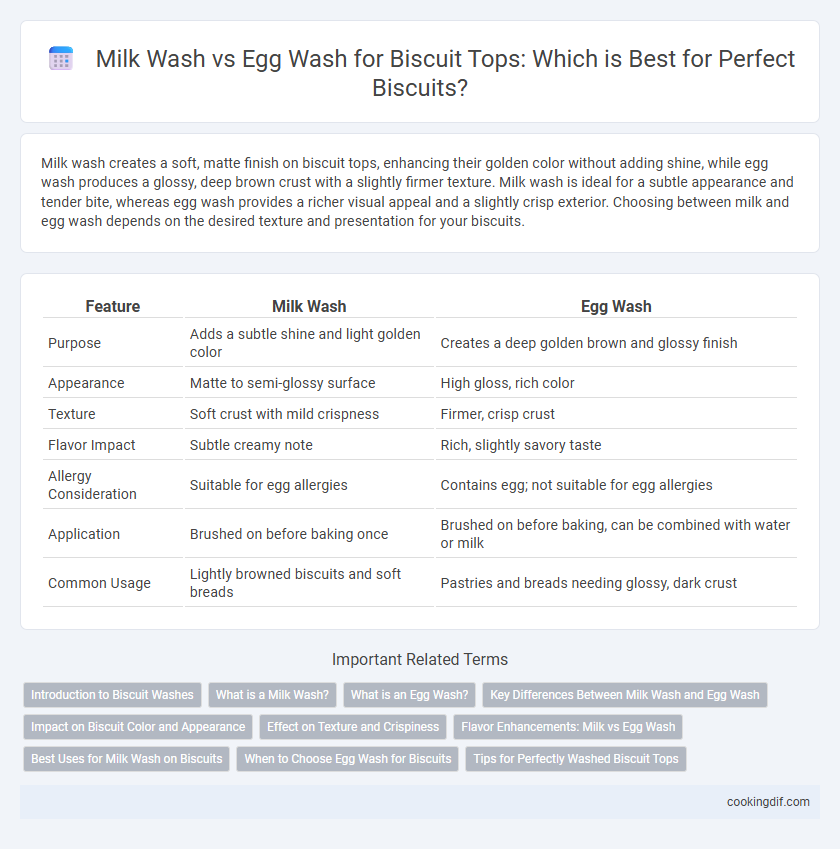Milk wash creates a soft, matte finish on biscuit tops, enhancing their golden color without adding shine, while egg wash produces a glossy, deep brown crust with a slightly firmer texture. Milk wash is ideal for a subtle appearance and tender bite, whereas egg wash provides a richer visual appeal and a slightly crisp exterior. Choosing between milk and egg wash depends on the desired texture and presentation for your biscuits.
Table of Comparison
| Feature | Milk Wash | Egg Wash |
|---|---|---|
| Purpose | Adds a subtle shine and light golden color | Creates a deep golden brown and glossy finish |
| Appearance | Matte to semi-glossy surface | High gloss, rich color |
| Texture | Soft crust with mild crispness | Firmer, crisp crust |
| Flavor Impact | Subtle creamy note | Rich, slightly savory taste |
| Allergy Consideration | Suitable for egg allergies | Contains egg; not suitable for egg allergies |
| Application | Brushed on before baking once | Brushed on before baking, can be combined with water or milk |
| Common Usage | Lightly browned biscuits and soft breads | Pastries and breads needing glossy, dark crust |
Introduction to Biscuit Washes
Milk wash creates a slightly glossy, tender crust on biscuit tops by adding moisture and mild sweetness, while egg wash delivers a rich, golden-brown sheen with a firmer texture due to the protein and fat content. Choosing between milk and egg washes depends on the desired appearance and crust characteristics, as milk wash enhances softness and subtle browning, whereas egg wash promotes a shiny, crispy finish. Understanding these differences helps bakers achieve specific biscuit aesthetics and textures tailored to their recipes.
What is a Milk Wash?
A milk wash is a simple coating made by brushing milk over biscuit tops before baking, which creates a subtle sheen and helps achieve a golden-brown color. It enhances the biscuit's surface texture without adding gloss or altering flavor significantly, making it ideal for a soft, tender crust. Unlike egg wash, milk wash produces a more matte finish and a delicate browning effect.
What is an Egg Wash?
An egg wash is a mixture of beaten eggs, sometimes combined with water or milk, used to brush over biscuit tops before baking to create a golden, glossy finish. This technique enhances the appearance by promoting browning through the Maillard reaction. Compared to milk wash, egg wash provides a richer color and a slightly crispier texture on the biscuit surface.
Key Differences Between Milk Wash and Egg Wash
Milk wash creates a soft, matte finish on biscuit tops, enhancing browning without adding shine. Egg wash offers a glossy, golden crust and promotes a slightly crisp texture due to its protein content. The choice depends on whether a subtle or more pronounced appearance and texture are desired for the biscuits.
Impact on Biscuit Color and Appearance
Milk wash creates a gentle golden-brown hue on biscuit tops, enhancing a soft, matte finish, while egg wash produces a darker, shinier, and more vibrant crust due to its protein and fat content. Egg washes yield a glossier appearance that highlights texture and browning, making biscuits visually striking and appetizing. Milk wash results in a more subtle, evenly browned surface, preferred for a natural, less shiny look on biscuit tops.
Effect on Texture and Crispiness
Milk wash on biscuit tops creates a slightly tender and soft texture while enhancing a subtle golden color, contributing to moderate crispiness. Egg wash forms a glossy, firm crust with a more pronounced crispiness and a richer color, often resulting in a firmer bite. Choosing between milk and egg wash directly influences the biscuit's surface texture and the extent of its crisp outer layer.
Flavor Enhancements: Milk vs Egg Wash
Milk wash on biscuit tops imparts a subtle, creamy sweetness and creates a soft, golden-brown crust that enhances the overall flavor without overpowering it. Egg wash delivers a richer taste and a glossy, deep amber finish with a slightly savory note, intensifying the biscuit's natural flavors. Both washes contribute to appealing texture variations, with milk providing a tender crust and egg wash offering a firmer, more pronounced exterior flavor.
Best Uses for Milk Wash on Biscuits
Milk wash enhances biscuit tops by creating a soft, slightly glossy finish that maintains a tender texture, making it ideal for biscuits that require a delicate appearance and gentle browning. Its natural sugars aid in subtle caramelization without overpowering flavor or crispness, perfect for buttermilk or flaky biscuits. Milk wash suits savory or sweet recipes where a light, golden sheen is preferred over the crunchy texture achieved with egg wash.
When to Choose Egg Wash for Biscuits
Egg wash is ideal for biscuit tops when a glossy, golden-brown finish is desired, offering a rich color and slightly crisp texture. It works best for special occasions or when presentation is a priority, enhancing visual appeal and making biscuits stand out. Choose egg wash if you want a more vibrant, shiny crust that contrasts with the soft, tender interior of the biscuit.
Tips for Perfectly Washed Biscuit Tops
Milk wash creates a tender, golden-brown biscuit top with a subtle shine, while egg wash offers a richer, glossy finish and deeper color intensity. For perfectly washed biscuit tops, apply a thin, even layer of wash before baking using a pastry brush to avoid pooling and sogginess. Using cold milk or lightly beaten eggs with a splash of water can improve application and prevent cracking during baking.
Milk wash vs Egg wash for biscuit tops Infographic

 cookingdif.com
cookingdif.com